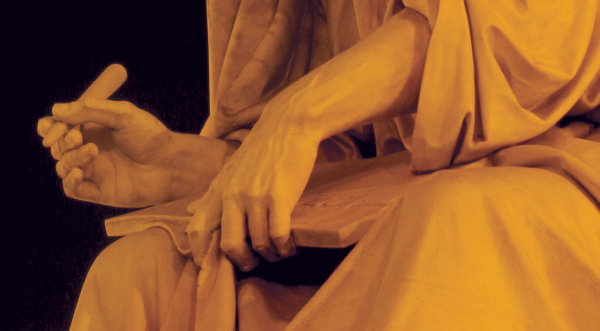
God, through his prophet, uses a natural catastrophe to call his people to repentance, reminding them that they are not alone in suffering, since all the nations are under God’s judgment. Israel’s economy was mainly agricultural during the OT period, so locusts were a catastrophe for them. These voracious insects strip all green vegetation, leaving nothing to harvest to provide food for either people or livestock. But repentance will lead to restoration, and blessing will replace barrenness.
Author
Joel, whose name means “the LORD [Yah(weh)] is God,” is the prophet through whom God speaks. He cannot be identified with any of the 12 others with the same name in the OT. His only identification in the book is through his father, who is otherwise unknown, but no date or geographic location is given. He does not appear to be strictly a court or temple prophet but one for the people since the woes he describes and the blessing he envisions affect all levels of society. His only mention outside this book is the reference to his prophecy in Acts 2:16.
Date
The book is extremely difficult to date since its main event is an ecological crisis, a locust swarm, which was, unfortunately, too common an occurrence to provide help in dating the book. Since the prophecy mentions “Israel” so rarely, the northern kingdom of Israel had probably already suffered its exile in 722 BC, as supported by 3:2. Since the temple and its rituals were still in operation (2:17), the prophecy either precedes its destruction in 586 BC or follows its rebuilding in 516 or 515 BC. Even though its exact chronology is unclear, the book’s message is timeless.
Occasion and Purpose
A natural catastrophe such as this locust swarm, threatening Judah’s very existence, would have driven them to their knees, literally and theologically. How could God let this happen to his chosen people? Joel affirms the people in their emotional reaction, telling them to not only lament but repent. God will restore his people while also judging their enemies. The end focus of the prophecy is not on despair but on the God who dwells among his people.
Rather than simply being the reminder of a catastrophe, the prophecy also serves as a model. Destruction, lamentation, and repentance leading to restoration are steps applicable to many periods of existence, both for a nation and for an individual. The prophecy can well serve as a liturgy for life.
Genre and Structure
As prophecy, Joel is mainly poetic, and as such employs techniques such as simile (1:8, 15; 2:2, 3b–5, 7, 9) and metaphor (1:6, 10, 12, 19; 2:3a, 13, 21, 25, 28–29; 3:13, 16, 18). It remembers times of calamity past (1:2—2:27) in anticipation of future judgment (2:28—3:21), frequently reusing words and motifs throughout the book, showing its conceptual unity. It twice details the precipitating event for Judah, a devastating swarm of locusts (1:2–12; 2:1–11), with subsequent calls to lament and repent (1:13–20; 2:12–17), after which the Lord promises restoration and blessing (2:18–27). The pattern is modified, though on a more global scale, with the impending judgment upon the nations (2:28—3:16). This judgment is not mitigated since there is no mention of international repentance, though God will restore and bless his people who repent (3:17–21).
Themes and Theology
The Lord, Yahweh, the God of Israel, unites this book from beginning (twice in 1:1 [once within the prophet’s name, see Author]) to end (3:21). His name occurs 33 times, and the common noun “God” occurs 11 times. He is referred to in other ways over 50 times. This averages more than one reference to Israel’s God per verse of the book. The book highlights specific areas of God’s activities that relate to time (the “day of the LORD”) and to place (Zion).
The “day of the LORD” plays an important part in the theology of Joel (1:15; 2:1, 11, 31; 3:14; see also 2:2, 29; 3:1, 18). Israel anticipated it as a time for God to bless his people (Amos 5:18). False prophets twisted the concept, suggesting that simply being God’s chosen people, Israel, was sufficient to trigger this blessing. It did not matter how the people acted in relation to the covenant requirements (Jer 14:13–15; Mic 3:5); sinner or saint, Israel would be blessed. But faithfulness, not ancestry, brings blessing. A lack of faithfulness, whether by Israel (2:31–32) or anyone else (3:11–16), brings judgment and punishment. The day can focus on different time periods, depending on its context. In some cases it refers to an eschatological, epoch-changing event at the end of this age that ushers in the age to come (2:31), while at other times it refers to smaller and closer cataclysmic events in which God intervenes in history (1:15; 2:1, 11; 3:14; 1 Cor 1:8; 2 Thess 2:2; 2 Pet 3:10). The latter prefigure and anticipate the former.
A key location is Zion (2:1, 15, 23, 32; 3:16, 17, 21) the location of the temple in Jerusalem (2:32; 3:1, 6, 16, 17, 20). As the site of God’s dwelling (3:17), the temple is the source of blessing when God’s people follow him (2:15, 23, 32; 3:1, 17, 20–21). The prophecy also warns of destructive judgment when God’s people turn their back on their covenant promises to him (2:1; 3:16, 21).
Outline
I. Heading (1:1)
II. The Lord’s Call to Judah to Lament and Repent (1:2—2:17)
A. An Invasion of Locusts (1:2–12)
B. A Call to Lamentation (1:13–20)
C. An Army of Locusts (2:1–11)
D. Rend Your Heart (2:12–17)
III. The Lord Responds to His People (2:18—3:21)
A. The Lord’s Answer (2:18–27)
B. The Day of the Lord (2:28–32)
C. The Nations Judged (3:1–16)
1. Why They Are Judged (3:1–3)
2. Payback (3:4–8)
3. Calling to the Nations (3:9–16)
D. Blessing for God’s People (3:17–21)
![]()
![]()
![]()

